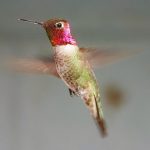Allen's hummingbird
 |
| Photo by Alexander Viduetsky (Internet Bird Collection) |
Common name:
Allen’s hummingbird (en); beija-flor-de-Allen (pt); colibri d’Allen (fr); colibrí de Allen (es); Allenkolibri (de)
Taxonomy:
Order Apodiformes
Family Trochilidae
Range:
This species occurs in western North America. The nominate susbspecies S. s. sasin is migratory, breeding along the western coast of the United States, from Oregon to southern California, and wintering in central Mexico. The other subspecies S. s. sedentarius is resident, originally being found on the Channel Islands, off southern California, but having colonized since the 1960s the Los Angeles and Orange counties in southern California.
Size:
These tiny birds are 7,5-9 cm long and have a wingspan of 11 cm. They weigh just 2-4 g.
Habitat:
They breed in moist coastal areas, including scrublands, chaparral and forests. Outside the breeding season they are found in both dry and moist scrublands and dry tropical forests.
Diet:
Allen’s hummingbirds mainly feed on the nectar of various flowers, especially red tubular flowers such as penstemons, red monkeyflowers, red columbines, paintbrush and scarlet sage. They also eat tree sap and small insects such as flies, ants, small beetles and tiny wasps, and spiders.
Breeding:
These birds breed in November-June. They are polygynous, with each male matting with several females and having no further part on the breeding process. The female builds the nest alone, a tiny cup made of moss, lichens, spider webs, bark flakes and pine needles, placed in a scrub or on a small twig or branch of a tree. There she lays 2 white eggs, which she incubates alone for 16-22 days. The chicks are raised by the female and fledge 22-25 days after hatching, immediately becoming independent from their mother.
Conservation:
IUCN status – LC (Least Concern)
This species has a relatively small breeding range and a global population estimated at 530.000 individuals. The population may the undergoing a small decline but the quality of data is not very reliable.
































